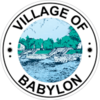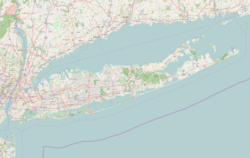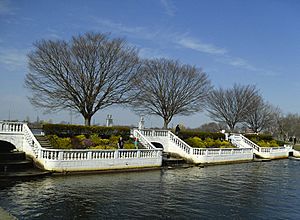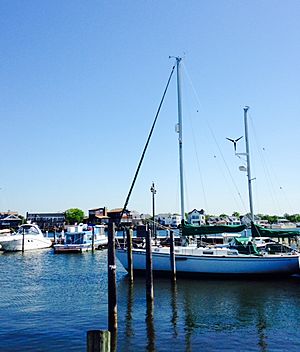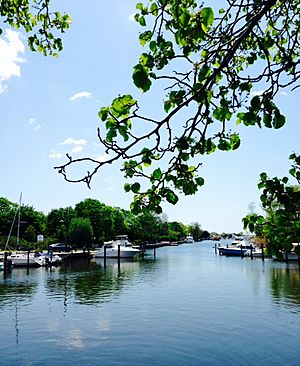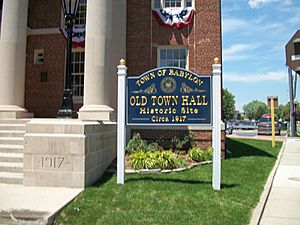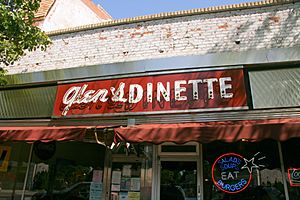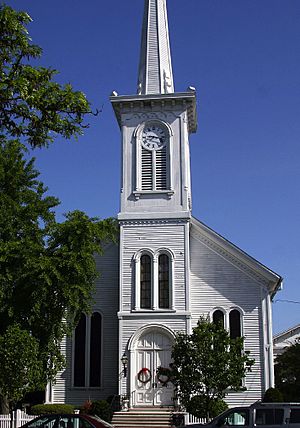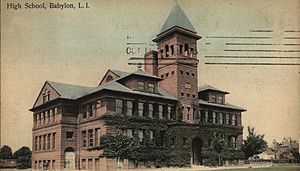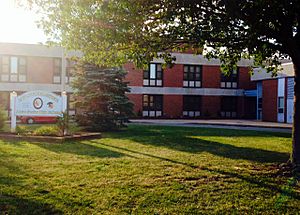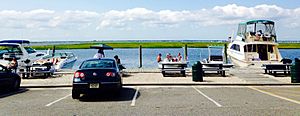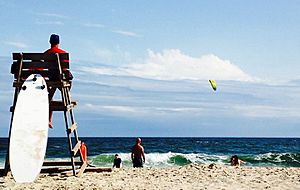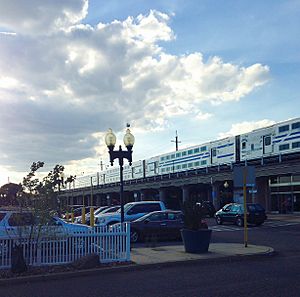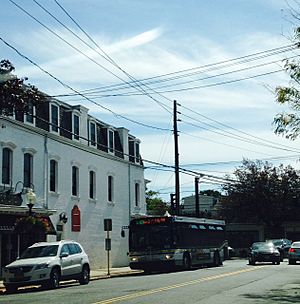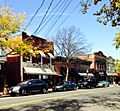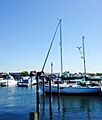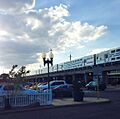Babylon (village), New York facts for kids
Quick facts for kids
Babylon, New York
|
||
|---|---|---|
| Incorporated Village of Babylon | ||
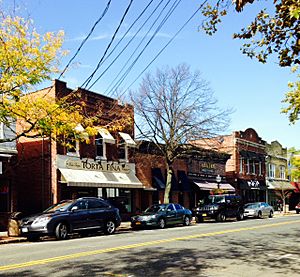
Deer Park Avenue in Babylon Village
|
||
|
||
| Nickname(s):
Babylon Village; The Village
|
||
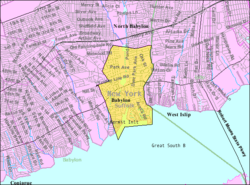 |
||
| Country | ||
| State | ||
| County | Suffolk | |
| Town | Babylon | |
| Incorporated | 1893 | |
| Area | ||
| • Total | 2.79 sq mi (7.24 km2) | |
| • Land | 2.41 sq mi (6.24 km2) | |
| • Water | 0.38 sq mi (0.99 km2) | |
| Elevation | 7 ft (2 m) | |
| Population
(2020)
|
||
| • Total | 12,188 | |
| • Density | 5,055.16/sq mi (1,952.09/km2) | |
| Time zone | UTC-5 (EST) | |
| • Summer (DST) | UTC-4 (EDT) | |
| ZIP Code |
11702
|
|
| Area codes | 631, 934 | |
| FIPS code | 36-03408 | |
| GNIS feature ID | 0942756 | |
| Website | ||
Babylon is a small village located within the larger Town of Babylon in Suffolk County, New York. In 2020, about 12,188 people lived here. It's pretty close to New York City, about 25 miles from the Queens border and 33 miles from Manhattan.
The village's official name is The Incorporated Village of Babylon. People often call it Babylon Village to avoid confusing it with the bigger Town of Babylon.
Contents
Exploring Babylon's Past
What we know today as Babylon Town and Village was once part of Huntington Town. It was called Huntington South. People started settling here around 1689. The main business was harvesting "salt hay," which was used to feed and bed cattle.
By 1803, a community had grown. Local citizens wanted a new name. A lady named Mrs. Conklin, who was used to living inland, felt uneasy about the new location. She compared the new hamlet to the ancient city of Babylon from the Bible. She suggested this name, perhaps to challenge the area's reputation as just a stop for travelers on Long Island. Her son thought the name was "unholy," but she reportedly said, "But it will be a new Babylon." The name stuck!
Hotels and Fire Island Gateway
Babylon quickly became the main way to reach the nearby barrier beaches, like Fire Island. This was true until new causeways were built for cars. Before that, people coming by train or coach would stay at local hotels. They would then take the Babylon Railroad, which was first a horsecar line and later a trolley, to the Babylon Dock. From there, ferries took them to places like Oak Island and Fire Island.
Many wealthy people spent their summers at Babylon's seaside resorts. Some resorts were on the mainland, and others were on the barrier islands. For example, Muncie Island had a fancy sanatorium. Saltaire had the Surf Hotel, which offered hundreds of rooms. Guests would take the train to Babylon's trolley, then cross the bay by ferry. Some of the most luxurious hotels were the South Shore Inn and Watson House.
Some of Babylon's old hotels included:
- American Hotel
- The Argyle
- Boynes Hotel
- East End Hotel
- La Grange Inn (now a museum)
- Sherman House
- South Shore Inn
- Surf Hotel
- Watson House
Argyle Hotel and Park
The famous Argyle Hotel was built in 1882 for rich summer visitors from New York City. It was a huge hotel with 350 rooms. However, it was often mostly empty. It was torn down in 1904. Some of its materials were used to build homes nearby.
The land where the hotel stood, including a large pond called Blythebourne Lake, was renamed Argyle Lake. In 1921, this land became Argyle Park, a public park for the Village of Babylon. Today, the park is still popular. People come here for fishing, walking, playing on the playground, and even ice skating in winter.
Old Mills and Estates
Effingham Park was home to the Old Mill, one of the first buildings in the village area. It was used for grinding grain for about 100 years. Later, it became a toy whip factory.
The park eventually belonged to Edwin Hawley, a railroad tycoon. He built a grand estate there. He also created a beautiful waterfall that was said to be even more splendid than the one at Argyle Memorial Park. The Hawley Estate was private, with tall hedges and fancy fences.
Later, when a new highway (Route 231) was built, it went right through the estate. This changed the park a lot. Today, Hawley's Lake Park is not used much because it's hard to get to and doesn't have parking.
Baseball and African-American History
Many of the black workers at the Argyle Hotel formed a baseball team called the Babylon Black Panthers. This team is believed to be the first black professional baseball team. They were so good that a promoter helped them travel and play as the "Cuban Giants." Even though they were called "Cuban," there were no Cubans on the team. This was a common way to refer to black players back then.
The team became the "world colored champions" in 1887 and 1888. They inspired other teams. Today, Babylon Village has three baseball fields, and the high school team is called the Babylon Panthers. The Babylon Panthers varsity baseball team has won several championships.
Babylon Village also has one of Long Island's oldest continuous African-American communities. The Argyle Hotel employees helped start this community. Two of the village's 12 churches, the Ebenezer Baptist Church and the Bethel African Methodist Episcopal Church, are part of this community.
A famous film actress, Butterfly McQueen, also lived in Babylon. She was known for her role in Gone with the Wind. She graduated from Babylon High School before starting her acting career.
Hurricane Sandy's Impact
On October 29, 2012, Hurricane Sandy caused a lot of damage in Babylon Village. Many homes and businesses, especially those south of Main Street near the Great South Bay, were flooded. The storm surge was as high as six feet. This damage forced many families to leave their homes for several months.
Babylon Today
Today, Babylon is a mix of a suburban town and a small community. It has a busy shopping and business district. The village is well-known for its many restaurants and shops. It also hosts fun shopping events in the fall and a popular crafts fair.
In 2003, a statue of Robert Moses, a famous urban planner, was put in front of the Village Hall on Main Street.
Homes and Neighborhoods
Babylon has a variety of homes because it's been a community for a long time. Many buildings date back to before the American Civil War and World War I. You can see different styles, like colonial, Victorian, and more modern designs.
Near the shore, many homes were originally summer houses, including large mansions and smaller cottages. Most of these are now used year-round. Because there isn't much open land left, Babylon Village doesn't have many large housing developments built all at once.
Newer, larger homes have been built on former wetlands. In recent years, some smaller, older houses on good lots have been replaced with much larger, modern homes.
Places of Worship
Babylon Village has many different churches and places of worship:
- Bethel A.M.E. Church
- Christ Episcopal Church
- Congregation Beth Sholom
- Cross of Christ Lutheran Church
- Ebenezer Baptist Church
- First Baptist Church of Babylon
- First Presbyterian Church of Babylon
- Point Church
- St. Nicholas' Greek Orthodox Church (in West Babylon)
- St. Joseph's Roman Catholic Church
- Seventh Day Adventist Church
- United Methodist Church of Babylon
Public Schools
Most kids in Babylon Village go to schools in the Babylon Union Free School District. However, some parts of the village are in the West Babylon School District. Also, some students from nearby areas like Oak Island go to Babylon schools.
In the 2010-2011 school year, the Babylon Union Free School District had 1,788 students. Most students were non-Hispanic white (84%), with smaller percentages of Hispanic or Latino (8%), non-Hispanic black (4%), and Asian (3%) students. The graduation rate was very high, at 94%. Most graduates went on to college.
The Babylon Union Free School District has three schools:
- Babylon Elementary School: For students in kindergarten through 2nd grade.
- Babylon Grade School: For students in 3rd through 6th grade. Both elementary and grade schools are on one large campus.
- Babylon Junior-Senior High School: For grades 7-12. It's in the original, but updated, High School building across from the Babylon Railroad Station.
Some Babylon Village children attend schools in the West Babylon School District. These include:
- John F. Kennedy Elementary School or South Bay School: For grades K-5.
- West Babylon Junior High School: For grades 6-8.
- West Babylon High School: For grades 9-12.
The famous poet Walt Whitman once taught at a school in West Babylon during the winter of 1836-37.
Where is Babylon?
Babylon Village covers about 2.8 square miles (7.1 km²). Most of this is land (2.4 square miles or 6.2 km²), and a smaller part is water (0.3 square miles or 0.9 km²).
The village is surrounded by other towns:
- To the west: West Babylon
- To the north: North Babylon
- To the east: West Islip
- To the south: The Great South Bay
People of Babylon
| Historical population | |||
|---|---|---|---|
| Census | Pop. | %± | |
| 1840 | 250 | — | |
| 1850 | 300 | 20.0% | |
| 1860 | 470 | 56.7% | |
| 1870 | 1,225 | 160.6% | |
| 1880 | 2,142 | 74.9% | |
| 1900 | 2,157 | — | |
| 1910 | 2,600 | 20.5% | |
| 1920 | 2,523 | −3.0% | |
| 1930 | 4,342 | 72.1% | |
| 1940 | 4,742 | 9.2% | |
| 1950 | 6,015 | 26.8% | |
| 1960 | 11,062 | 83.9% | |
| 1970 | 12,897 | 16.6% | |
| 1980 | 12,388 | −3.9% | |
| 1990 | 12,249 | −1.1% | |
| 2000 | 12,615 | 3.0% | |
| 2010 | 12,166 | −3.6% | |
| 2020 | 12,188 | 0.2% | |
| U.S. Decennial Census | |||
In 2020, Babylon Village had 12,188 people living in 4,676 homes. On average, there were about 2.6 people per household.
Most residents (89.3%) were White. There were also people who identified as African American (0.6%), Native American (0.7%), Asian (1.5%), and from two or more races (4.1%). About 9.8% of the population was Hispanic or Latino.
About 19% of the population was under 18 years old, and 18.7% were over 65. Slightly more than half (51.9%) of the population was female.
Most people (78.2%) owned their homes. About 8.8% of the population was born outside the U.S. Also, 8.6% of residents aged 5 and older spoke a language other than English at home.
Most adults (95.1%) had graduated from high school, and 39.6% had a bachelor's degree or higher. The average time it took for people to travel to work was about 31.4 minutes. The average household income was $127,407. Only a small percentage of the population (4.5%) lived below the poverty line.
Getting Around Babylon
Babylon has good transportation options. The Babylon station is the last stop for the Babylon Branch of the Long Island Rail Road. It's also served by the Montauk Branch. This means you can travel to both the far west and far east ends of Long Island from Babylon. This makes it great for people who commute. A train ride from Babylon to New York City's Penn Station usually takes about 55 minutes to 1 hour and 15 minutes.
The train station is also a main stop for several buses run by Suffolk County Transit:
- Bus 2: Travels between Amityville LIRR station and Patchogue LIRR station.
- Bus 3: Goes from Babylon LIRR station to Walt Whitman Shops.
- Bus 5: Connects Babylon LIRR station to Smith Haven Mall.
- Bus 10: Runs between Amityville LIRR station and Babylon LIRR station.
- Bus 15: Provides summer service from Babylon LIRR station to Robert Moses State Park.
Famous People from Babylon
Many notable people have connections to Babylon:
- Danielle Ammaccapane: Professional golfer.
- Tom Bohrer: Two-time Olympic rowing silver medalist.
- Connie Carberg: First female NFL scout.
- Rodney Dangerfield: Comedian and actor.
- Billy Hayes: Author of Midnight Express.
- Steve Janaszak: Backup goalie for the 1980 US Olympic ice hockey team (Miracle on Ice).
- Bob Keeshan: TV personality, known as Captain Kangaroo.
- Guglielmo Marconi: Inventor of wireless telegraphy.
- Ashley Massaro: Former WWE Diva.
- Butterfly McQueen: Film actress, famous for Gone with the Wind.
- Dan Meuser: US Representative from Pennsylvania.
- Robert Moses: Famous urban planner.
- Bret Saberhagen: Professional baseball pitcher, won the Cy Young Award.
- Mike Scaccia: Guitarist for metal bands Ministry and Rigor Mortis.
- Mary Schapiro: Former head of the U.S. Securities and Exchange Commission.
- William Shepherd: Former Navy SEAL and NASA astronaut.
- Chris Wingert: Professional soccer player.
Images for kids
See also
 In Spanish: Babylon (condado de Suffolk, Nueva York) para niños
In Spanish: Babylon (condado de Suffolk, Nueva York) para niños


